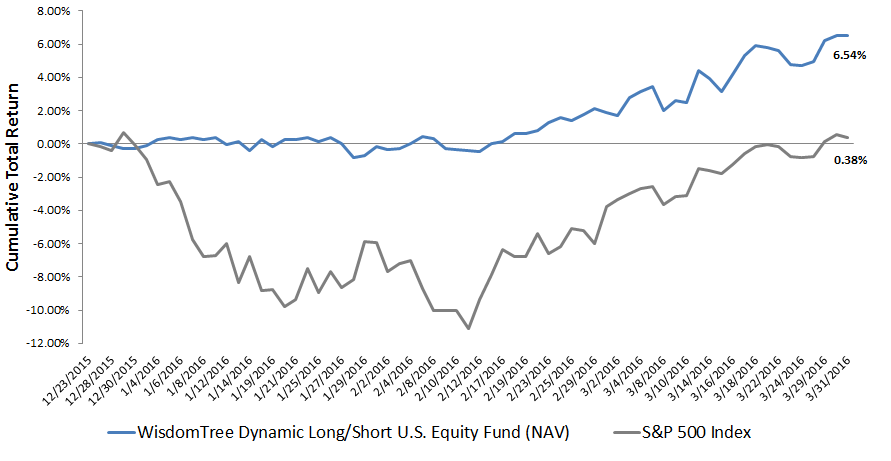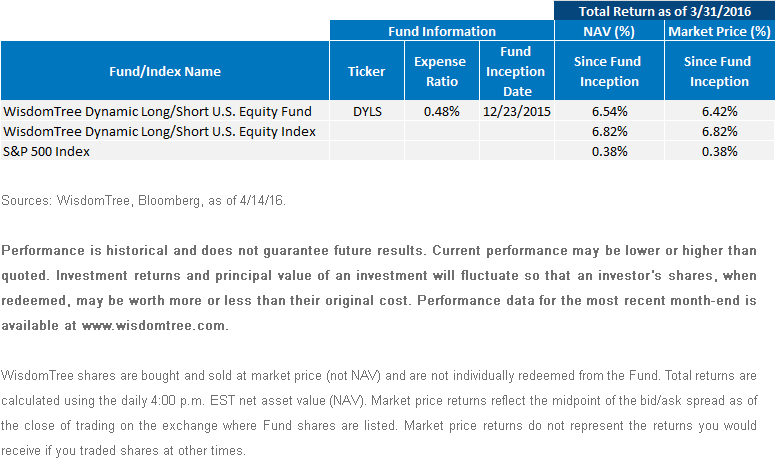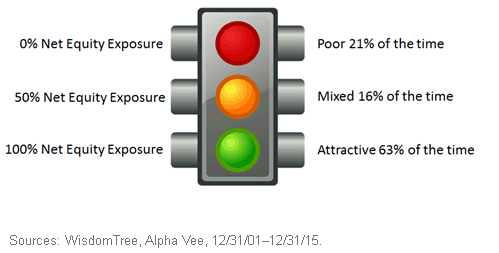Red Light, Green Light: Turning Net Equity Exposure On and Off



 It’s apparent from the chart that DYLS treaded water through the first two months of the year, while the S&P 500 was off to one of its worst starts in history. The WisdomTree Fund was able to stay afloat because it maintained a market-neutral exposure for the first two months of the year. Put another way, its long portfolio of stocks was 100% hedged by being short the S&P 500. That hedge came off in March, and as a result, DYLS has since moved broadly with the U.S. equity market, as the S&P 500 recovered.
Ultimately, two key questions drive the construction of the underlying strategy: “What stocks should you own?” and “When should you be 100% exposed to them?”
With respect to what stocks to own, two factors—growth and value—determine which companies are selected, and one factor—volatility—drives their weight in the DYLS portfolio. Stocks earn a growth score and a value score based on various measurements relevant to the sector they come from. Stocks with the highest scores are selected each quarter and assigned weights so that overall sector exposure is similar to the market. However, rather than weighting by a company’s market value, WisdomTree sets weights based on a stocks volatility multiplied by its beta, in effect rewarding lower-volatility stocks with greater weights. This weighting methodology, along with the sector constraints, helps the “long” portion of the portfolio correlate with the broader movement of the market, while giving DYLS the potential to provide some measure of downside protection compared to the S&P 500 when equity markets decline. Put another way, DYLS combines quality and value in the selection process and low volatility in the weighting process in a sector-neutral attempt to add alpha on the “long” side of the portfolio.
But over longer holding periods, the performance DYLS posts compared to the S&P 500, on both an absolute and risk-adjusted basis, will be driven by how effective it is at hedging out market risk when market fundamentals deteriorate and stocks decline in the U.S. This means that if the hedging indicator signals 50% or 0% net equity exposure as the market rallies, the WisdomTree Index would experience less of that upside gain. Conversely, if the Index is 100 percent long when stock markets fall, it will likely experience losses with the broader market. So much of the efficacy of the strategy comes down to how well the hedging signal works.
To answer the second question—“When do you hedge the market?”—note the visual aid below. Because a hedging signal is generated at the end of each month, investors in DYLS can have their net equity exposure dialed down from 100% to 50% to 0%, depending on market conditions.
It’s apparent from the chart that DYLS treaded water through the first two months of the year, while the S&P 500 was off to one of its worst starts in history. The WisdomTree Fund was able to stay afloat because it maintained a market-neutral exposure for the first two months of the year. Put another way, its long portfolio of stocks was 100% hedged by being short the S&P 500. That hedge came off in March, and as a result, DYLS has since moved broadly with the U.S. equity market, as the S&P 500 recovered.
Ultimately, two key questions drive the construction of the underlying strategy: “What stocks should you own?” and “When should you be 100% exposed to them?”
With respect to what stocks to own, two factors—growth and value—determine which companies are selected, and one factor—volatility—drives their weight in the DYLS portfolio. Stocks earn a growth score and a value score based on various measurements relevant to the sector they come from. Stocks with the highest scores are selected each quarter and assigned weights so that overall sector exposure is similar to the market. However, rather than weighting by a company’s market value, WisdomTree sets weights based on a stocks volatility multiplied by its beta, in effect rewarding lower-volatility stocks with greater weights. This weighting methodology, along with the sector constraints, helps the “long” portion of the portfolio correlate with the broader movement of the market, while giving DYLS the potential to provide some measure of downside protection compared to the S&P 500 when equity markets decline. Put another way, DYLS combines quality and value in the selection process and low volatility in the weighting process in a sector-neutral attempt to add alpha on the “long” side of the portfolio.
But over longer holding periods, the performance DYLS posts compared to the S&P 500, on both an absolute and risk-adjusted basis, will be driven by how effective it is at hedging out market risk when market fundamentals deteriorate and stocks decline in the U.S. This means that if the hedging indicator signals 50% or 0% net equity exposure as the market rallies, the WisdomTree Index would experience less of that upside gain. Conversely, if the Index is 100 percent long when stock markets fall, it will likely experience losses with the broader market. So much of the efficacy of the strategy comes down to how well the hedging signal works.
To answer the second question—“When do you hedge the market?”—note the visual aid below. Because a hedging signal is generated at the end of each month, investors in DYLS can have their net equity exposure dialed down from 100% to 50% to 0%, depending on market conditions.
 Essentially, DYLS has three “modes” informed by the hedging ratio: green for go, yellow for caution and red for market neutral. Looking over the past 15 years, the hedge ratio has been green 63% of the time, yellow 16% of the time and red 21% of the time.1 Much like the stocks that the Index holds in its long portfolio, growth and value indicators are what decide when the Index views the market as attractive, mixed or poor. The key drivers for a green light are expanding profits, as measured by operating profit margins, net income profit margins and profit quality. In addition, value indicators —as measured by price to book and price to cash flow—also contribute to the net equity exposure decision on a month-to-month basis. These same signals moving in the opposite direction would trigger a red light, while a mixture of readings would advise the Index to proceed with caution.
Conclusion
For investors looking for ways to potentially reduce volatility in their portfolios, DYLS can complement an equity portfolio by helping maintain a long equity position while potentially increasing risk-adjusted returns. In a world in which investors are looking for alternatives to illiquid, high-fee, hedge fund-type strategies, WisdomTree democratizes the long/short approach and demystifies the process, while reducing the cost of implementing such a strategy.
1The hedge ratios’ signals are from a universe meant to represent the broad U.S. market and are generated separately from DYLS and its underlying Index.
Essentially, DYLS has three “modes” informed by the hedging ratio: green for go, yellow for caution and red for market neutral. Looking over the past 15 years, the hedge ratio has been green 63% of the time, yellow 16% of the time and red 21% of the time.1 Much like the stocks that the Index holds in its long portfolio, growth and value indicators are what decide when the Index views the market as attractive, mixed or poor. The key drivers for a green light are expanding profits, as measured by operating profit margins, net income profit margins and profit quality. In addition, value indicators —as measured by price to book and price to cash flow—also contribute to the net equity exposure decision on a month-to-month basis. These same signals moving in the opposite direction would trigger a red light, while a mixture of readings would advise the Index to proceed with caution.
Conclusion
For investors looking for ways to potentially reduce volatility in their portfolios, DYLS can complement an equity portfolio by helping maintain a long equity position while potentially increasing risk-adjusted returns. In a world in which investors are looking for alternatives to illiquid, high-fee, hedge fund-type strategies, WisdomTree democratizes the long/short approach and demystifies the process, while reducing the cost of implementing such a strategy.
1The hedge ratios’ signals are from a universe meant to represent the broad U.S. market and are generated separately from DYLS and its underlying Index. Important Risks Related to this Article
There are risks associated with investing, including possible loss of principal. The Fund invests in derivatives, including as a substitute to gain short exposure to equity securities. Derivative investments can be volatile, and these investments may be less liquid than other securities, and more sensitive to the effects of varied economic conditions. Derivatives used by the Fund to offset its exposure to market volatility may not perform as intended. The Fund may engage in “short sale” transactions and will lose value if the security or instrument that is the subject of a short sale increases in value. A Fund that has exposure to one or more sectors may increase the Fund’s vulnerabilitybe more vulnerable to any single economic or regulatory development. This may result in greater share price volatility. The composition of the Index is heavily dependent on quantitative models and data from one or more third parties, and the Index may not perform as intended. The Fund invests in the securities included in, or representative of, its Index regardless of their investment merit, and the Fund does not attempt to outperform its Index or take defensive positions in declining markets. Please read the Fund’s prospectus for specific details regarding the Fund’s risk profile.
The composition of the Index is heavily dependent on quantitative models and data from one or more third parties, and the Index may not perform as intended. The Fund invests in the securities included in, or representative of, its Index regardless of their investment merit, and the Fund does not attempt to outperform its Index or take defensive positions in declining markets. Please read the Fund’s prospectus for specific details regarding the Fund’s risk profile.


